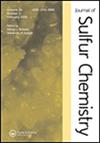含氮和含硫希夫碱铂(II)配合物的绿色微波辅助合成、表征和PXRD研究:抗结核、DNA切割和抗菌活性的评价
IF 1.6
3区 化学
Q3 CHEMISTRY, MULTIDISCIPLINARY
引用次数: 0
摘要
为了寻找具有重要药理意义的化合物,以双齿状NS席夫碱配体苄基-2-(1-(吡啶-2-基)乙基)肼-1-碳二硫酸盐(HL)为配体,采用微波辅助和热辅助两种方法合成了铂(II)配合物。该配体由二硫代氨基苄肼与1-(吡啶-2-基)乙比1- 1反应合成。对两种方法的结果进行了总结和比较。与热法相比,微波辅助反应在更短的时间内完成,产率更高。用各种物理化学方法对配体和金属配合物进行了结构表征。根据光谱和分析数据推断铂(II)配合物具有方形平面几何结构。我们对配体(HL)和铂配合物[Pt(L)2]的抗结核、DNA切割和抗菌活性进行了评估。此外,还研究了[Pt(HL)2]Cl2配合物的抗菌活性。发现铂配合物[Pt(L)2]能有效抑制结核分枝杆菌的生长。DNA切割研究表明,配体和金属配合物[Pt(L)2]都能完全切割金黄色葡萄球菌的DNA。抑菌试验表明,该配体和金属配合物对两种细菌(大肠杆菌和枯草芽孢杆菌)和两种真菌(黑曲霉和青霉菌)均具有抑菌和抗真菌作用。本文章由计算机程序翻译,如有差异,请以英文原文为准。
Green microwave-assisted synthesis, characterization, and PXRD studies of nitrogen- and sulfur-containing Schiff base platinum (II) complexes: evaluation of antituberculosis, DNA cleavage, and antimicrobial activities
In the pursuit of pharmacologically important compounds, platinum(II) complexes were synthesized using both green microwave-assisted and thermal methods with the bidentate NS Schiff base ligand benzyl-2-(1-(pyridine-2-yl)ethylidene)hydrazine-1-carbodithioate (HL). This ligand was synthesized through the reaction between benzyl hydrazinecarbodithioate and 1-(pyridine-2-yl)ethan-1-one. The results from both methods were summarized and compared. Microwave-assisted reactions were completed in a shorter time and yielded higher amounts of product compared to thermal methods. The structural characterization of both the ligand and metal complexes was performed using various physicochemical methods. A square planar geometry was inferred for the platinum(II) complexes based on spectral and analytical data. Both the ligand (HL) and the platinum complex, [Pt(L)2] were evaluated for antituberculosis, DNA cleavage, and antimicrobial activities. Additionally, the [Pt(HL)2]Cl2 complex was also investigated for antimicrobial activity. The platinum complex, [Pt(L)2] was found to effectively inhibit the growth of Mycobacterium tuberculosis. DNA cleavage studies suggested that both the ligand and the metal complex, [Pt(L)2] were able to completely cleave Staphylococcus aureus DNA. Antimicrobial testing showed that both the ligand and the metal complexes exhibited activity against two bacteria (Escherichia coli and Bacillus subtilis) and two fungi (Aspergillus niger and Penicillium chrysogenum), demonstrating antibacterial and antifungal effects.
求助全文
通过发布文献求助,成功后即可免费获取论文全文。
去求助
来源期刊

Journal of Sulfur Chemistry
CHEMISTRY, MULTIDISCIPLINARY-
CiteScore
4.10
自引率
9.10%
发文量
38
审稿时长
6-12 weeks
期刊介绍:
The Journal of Sulfur Chemistry is an international journal for the dissemination of scientific results in the rapidly expanding realm of sulfur chemistry. The journal publishes high quality reviews, full papers and communications in the following areas: organic and inorganic chemistry, industrial chemistry, materials and polymer chemistry, biological chemistry and interdisciplinary studies directly related to sulfur science.
Papers outlining theoretical, physical, mechanistic or synthetic studies pertaining to sulfur chemistry are welcome. Hence the target audience is made up of academic and industrial chemists with peripheral or focused interests in sulfur chemistry. Manuscripts that truly define the aims of the journal include, but are not limited to, those that offer: a) innovative use of sulfur reagents; b) new synthetic approaches to sulfur-containing biomolecules, materials or organic and organometallic compounds; c) theoretical and physical studies that facilitate the understanding of sulfur structure, bonding or reactivity; d) catalytic, selective, synthetically useful or noteworthy transformations of sulfur containing molecules; e) industrial applications of sulfur chemistry; f) unique sulfur atom or molecule involvement in interfacial phenomena; g) descriptions of solid phase or combinatorial methods involving sulfur containing substrates. Submissions pertaining to related atoms such as selenium and tellurium are also welcome. Articles offering routine heterocycle formation through established reactions of sulfur containing substrates are outside the scope of the journal.
 求助内容:
求助内容: 应助结果提醒方式:
应助结果提醒方式:


